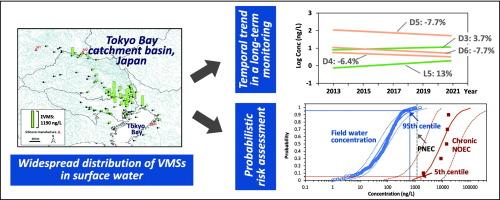东京湾流域挥发性甲基硅氧烷的时空变化趋势及生态风险评价:河流和污水处理厂样本
IF 8
1区 环境科学与生态学
Q1 ENVIRONMENTAL SCIENCES
引用次数: 0
摘要
挥发性甲基硅氧烷(VMSs)的大量生产及其高流动性和持久性引起了严重的环境污染问题。虽然对环境中持久性化合物浓度的时间趋势进行了相当大的探索,但对地表水的浓度,即地表水vss,几乎没有进行调查。基于此,我们研究了2013-2021年中国气候变化的时空趋势。日本东京湾流域河水和污水处理厂(STP)样品的线性vms (L3-L6)浓度。研究结果表明,河流水体中vms浓度普遍存在(2.3 ~ 1190 ng/L);在STP排放的下游检测到最高的VMS水平。然而,除D3外,在有机硅生产设施下游未检测到VMS浓度升高。时间趋势分析显示,在监测期间,D4、D5和D6浓度在统计上显著下降,年变化范围为- 7.7%至- 6.4%,这可能反映了为解决cmms而采取的监管行动的影响。我们对地表水D4、D5和D6对水生生物不利影响的风险评估显示,它们的分布在第95百分位的现场水浓度和第5百分位的慢性无观察效应水浓度之间不重叠,而它们的cVMS水平接近其预测的无观察效应浓度。此外,他们的水生环境对cVMS暴露的风险在研究期间呈下降趋势。总的来说,了解地表水VMS的时间趋势是实施必要的排放法规和评估未来对这些有机硅材料限制的有效性的关键。本文章由计算机程序翻译,如有差异,请以英文原文为准。

Spatiotemporal trends and ecological risk assessment of volatile methylsiloxanes in Tokyo Bay catchment basin, Japan: River water and sewage treatment plant samples
The large production volume of volatile methylsiloxanes (VMSs) and their high mobility and persistence present significant environmental-pollution concerns. Although the temporal trends of the persistent-compound concentrations of the environment have been considerably explored, those of surface water, namely surface water VMSs, have been barely investigated. Thus, we investigated the 2013–2021 spatiotemporal trends of the VMS (cyclic VMSs (cVMSs; D3–D6) and linear VMSs (L3–L6)) concentrations of river water and sewage treatment plant (STP) samples from the Tokyo Bay catchment basin, Japan. Our findings indicated the widespread concentrations of VMSs in the river water (2.3–1190 ng/L); the highest VMS levels were detected downstream of the STP discharges. However, no elevated VMS concentrations were detected downstream of silicone-manufacturing facilities, except for D3. The temporal trend analysis revealed statistically significant decreases in the D4, D5, and D6 concentrations within the monitoring period, with annual changes ranging from −7.7 % to −6.4 %, probably reflecting the impact of regulatory actions to address cVMSs. Our risk assessment of the adverse effects of surface water D4, D5, and D6 on aquatic organisms revealed that their distributions did not overlap between the 95th percentile field-water concentration and 5th percentile chronic no-observed-effect water concentration, whereas their cVMS levels were close to their predicted no-observed-effect concentrations. Furthermore, their risks of the aquatic environment to cVMS exposure displayed decreasing temporal trends during the study period. Overall, understanding temporal trends of surface water VMS is key to implementing necessary emission regulations and evaluating the effectiveness of future restrictions on these silicone materials.
求助全文
通过发布文献求助,成功后即可免费获取论文全文。
去求助
来源期刊

Science of the Total Environment
环境科学-环境科学
CiteScore
17.60
自引率
10.20%
发文量
8726
审稿时长
2.4 months
期刊介绍:
The Science of the Total Environment is an international journal dedicated to scientific research on the environment and its interaction with humanity. It covers a wide range of disciplines and seeks to publish innovative, hypothesis-driven, and impactful research that explores the entire environment, including the atmosphere, lithosphere, hydrosphere, biosphere, and anthroposphere.
The journal's updated Aims & Scope emphasizes the importance of interdisciplinary environmental research with broad impact. Priority is given to studies that advance fundamental understanding and explore the interconnectedness of multiple environmental spheres. Field studies are preferred, while laboratory experiments must demonstrate significant methodological advancements or mechanistic insights with direct relevance to the environment.
 求助内容:
求助内容: 应助结果提醒方式:
应助结果提醒方式:


